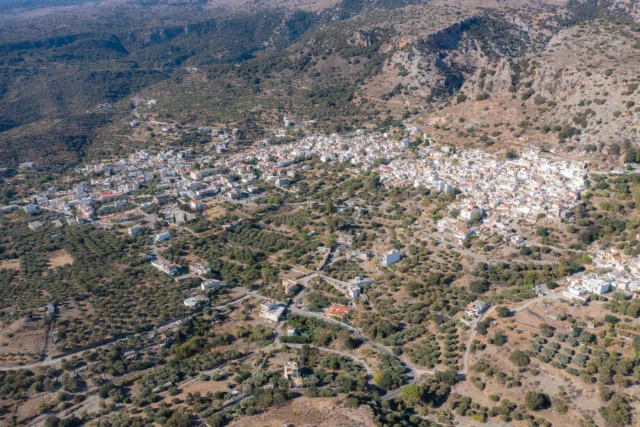
A Symbol of Resistance and Freedom
Rodanthi, often referred to as “Kritsotopoula” (meaning “the woman from Kritsa”), was a young Greek woman from the village of Kritsa, Crete, who became a symbol of resistance against the Ottoman rule in the 19th century. Her story, immortalized in a poem by Michalis Diallinas, is a testament to the courage and resilience of the Cretan people during their struggle for freedom.
Early Life and Family
Rodanthi was born in Kritsa, a village renowned for its rebellious spirit and resistance to Ottoman rule. Her father was the village’s protopapas (head priest), a figure of respect and authority within the community. This position likely afforded Rodanthi a certain level of education and social standing. She grew up in a time when Crete was under Ottoman occupation, and the Greek Orthodox faith and cultural traditions were important markers of identity and resistance.
The poem describes Rodanthi as a beautiful young woman with a captivating voice. She was known for singing while weaving, her melodic voice enchanting all who heard it. This image of Rodanthi as a skilled artisan and singer adds a layer of normalcy and relatability to her story, contrasting with the extraordinary events that would unfold in her life.
Abduction and Escape
Rodanthi’s life took a dramatic turn when a Turkish Aga, captivated by her beauty and voice, decided to abduct her. The Aga, likely a powerful local ruler, sent his men to Kritsa to seize Rodanthi. They killed her parents during the abduction, adding another layer of tragedy to the story.
Rodanthi was taken to the Aga’s harem, a secluded area within his residence where women were kept. The Aga intended to force Rodanthi to convert to Islam and marry him. However, Rodanthi had other plans. On the night of the forced wedding, she tricked the Aga, stabbing him with a hidden knife. Disguised in his clothes, she managed to escape into the night.
Joining the Resistance
Rodanthi, now disguised as a man named “Manolis,” sought refuge in the mountains of Crete, where rebel forces were actively fighting against the Ottoman occupation. She joined the band of Captain Kazanis, a renowned rebel leader. To further conceal her identity, she adopted the nickname “Spanomanolis” due to her lack of facial hair.
Rodanthi’s time with the rebels showcased her courage and skill in battle. She participated in various raids and skirmishes against Ottoman forces, earning the respect of her fellow rebels, who remained unaware of her true identity.
The Battle of Kritsa and Rodanthi’s Death
The climax of Rodanthi’s story unfolds during the Battle of Kritsa in 1823. The Ottoman army, seeking revenge for their losses and to quell the rebellious spirit of Kritsa, launched a major offensive against the village. The Cretan rebels, outnumbered but determined, prepared to defend their homeland.
Rodanthi, still disguised as Manolis, fought with exceptional bravery in the battle. She inspired her comrades to fight fiercely against the overwhelming odds. However, in the heat of the battle, she was mortally wounded. It was only then, as she lay dying, that her true identity was revealed.
Rodanthi’s death served as a catalyst for the Cretan rebels. Her sacrifice ignited a fire in their hearts, and they fought with renewed determination, ultimately repelling the Ottoman invaders and securing a victory for Kritsa.
Legacy and Symbolism
Rodanthi’s story has become an integral part of Cretan folklore and history. She is remembered as a symbol of resistance against oppression, a heroine who defied societal norms and expectations to fight for her freedom and her homeland. Her courage, her willingness to sacrifice her life for her people, and her unwavering spirit in the face of adversity have made her an inspiration to generations of Cretans.
In Kritsa, a statue has been erected in Rodanthi’s honor, commemorating her bravery and sacrifice. The church where her father served, the mountains where she sought refuge, and the battlefield where she fell are all places of remembrance and pilgrimage for those who admire her unwavering spirit.
Rodanthi’s story has also been adapted into various forms of art and literature, including plays, songs, and poems. These works serve to keep her memory alive and to inspire future generations with her story of courage and resilience.
Locations of Importance:
- Kritsa: Rodanthi’s birthplace and home, a village that embodies the spirit of Cretan resistance.
- The Church of Agios Georgios: Where Rodanthi’s father served as a priest, a place that symbolizes her faith and her connection to her community.
- The Mountains of Kritsa: Where Rodanthi sought refuge with the Cretan rebels, a testament to her courage and determination.
- The Battlefield of Kritsa: Where Rodanthi made the ultimate sacrifice for her homeland, a place that represents her unwavering love for freedom.
Rodanthi’s Symbolism:
Rodanthi’s death is a powerful symbol of resistance and freedom. Her story has inspired generations of Cretans to fight for their independence and their right to self-determination. Her name has become synonymous with courage, sacrifice, and the unwavering spirit of the Cretan people.
References
- Skoulikaris, Dimitris D. (2012). Kritsotopoula and the Battle of Kritsa of 1823.
Key points
- Place of Birth: Kritsa, Crete
- Cause of Death: Killed in battle during the Battle of Kritsa in 1823
- Nationality: Greek
- Legacy: Symbol of resistance against oppression, a heroine who fought for freedom, an inspiration to generations of Cretans.


